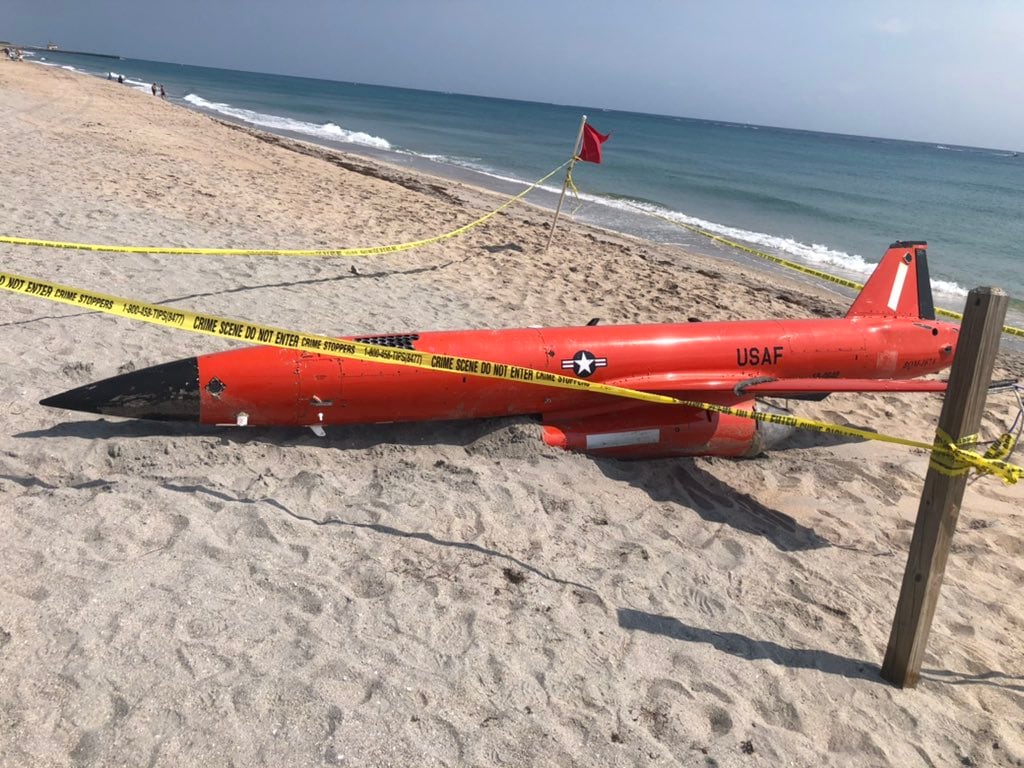Florida beaches are world renowned for their white sands, warm water and plentiful sea shells.
But they are also becoming known as a place where beachcombers can find military hardware washed ashore.
The latest incident took place Sunday morning, when law enforcement officials in Lauderdale-By-The-Sea came across something that at first blush looked potentially dangerous.
A Navy target mine had washed up on the sand.
A deputy on patrol from the Broward County Sheriff’s Office discovered the device around 2:30 a.m. BCSO deputies then secured the area around the item and closed off a small section of the beach, according to a BCSO media release. Though the item had the word “inert” written on it, out of an abundance of caution, the BCSO Bomb Squad responded and reached out to nearby Homestead Air Reserve Base.
The 482nd Explosive Ordnance Disposal team received a call about the mine at about 4:30 a.m., and arrived on scene at about 6 a.m., said Tech. Sgt. Lionel Castellano, a base spokesman, in an email to Military Times.
The EOD team performed a reconnaissance and diagnostics assessment, and determined the device to be a Mk 49 Mod 1 target mine with no explosive hazards, Castellano said. The EOD team assisted BCSO with transporting the mine to a BCSO holding area for later transfer to the Navy. The beach was later reopened.
The Navy could not immediately determine where the mine came from, a Navy official told Military Times.
The target mine was just the latest in a recent series of military devices washing up on area beaches that the Homestead EOD team had to investigate.
Including the mine, the team has been called out four times since March 19 to investigate potentially explosive devices on area beaches. Three times, it turned out to be an Air Force BQM-167A target drone.
Shortly after 10 a.m. on March 19, the Palm Beach Sheriff’s Office reported that a possible unexploded ordnance washed ashore in Boynton Beach.
RELATED

The EOD team responded and determined it to be a target drone that was carrying “unexpended chaff countermeasures,” small particles used to confuse radar. The EOD team removed the hazardous components to transport back to Homestead while the drone was secured by PBSO and returned to the Air Force.
Several hours later, while the EOD team was in Palm Beach, they received notification of another target drone washing ashore and towed to Ramrod Key, in Monroe County, which is part of the Florida Keys. The EOD team secured the drone on site to be returned to the Air Force, and secured dozens of flares used as countermeasures on site. Some were stored for later disposition and some were destroyed because “extensive corrosion and marine growth” made them inaccessible, Castellano said.
On March 28, a third target drone was discovered on Conch Key and towed to a marina. The EOD team secured it on site for later transfer to the Air Force.
The orange, 20-foot-long BQM-167A aerial target drone found on Boynton Beach March 19 came to rest in South Florida after launching from Tyndall Air Force Base in the Florida Panhandle, Air Force 1st Lt. Savannah Bray, 53rd Wing spokeswoman, told Military Times on March 19. Monday afternoon, however, Bray could not immediately confirm where the other two target drones came from, adding that base officials are researching the issue. A reporter for the local NBC affiliate posted photos of the drone found on Boynton Beach, surrounded by police tape, on Twitter March 19.

The 53rd Wing’s Weapons Evaluations Group flew the target drone from Tyndall over the military’s testing ranges in the Gulf of Mexico, Bray said in a March 19 email. That means it was likely carried by the Gulf Stream about 500 miles from where it was shot down, around the southern tip of Florida and up to its final resting spot. Its journey may have lasted two or three months, she said.
As Air Force fighter jets shoot down the drones during target practice, boats owned by the 53rd Wing head out to scoop up the downed planes. Each airframe costs $570,000 and can pull up to 9 Gs in flight, carrying payloads like electronic attack pods, a scoring system, and infrared and radar systems.
“Sometimes, like in this instance, weather, waves or other circumstances prevent our boats from being able to recover the drones, and they can wash up on shore,” Bray said. “The situation isn’t dangerous nor entirely uncommon.”
Air Force Times reporter Sarah Cohen contributed to this report.
Howard Altman is an award-winning editor and reporter who was previously the military reporter for the Tampa Bay Times and before that the Tampa Tribune, where he covered USCENTCOM, USSOCOM and SOF writ large among many other topics.





